| Fort Banks |
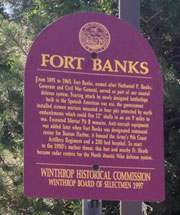 |
| Fort Banks |
|
| "From 1891 to 1965, Fort Banks, named after Nathaniel P. Banks, Governor and Civil War General, served as part of our coastal defense system. Fearing attack by newly designed battleships built in the Spanish American war era, the government installed sixteen mortars mounted in four pits which could fire 12” shells in an arc 9 miles to sea. Excavated Mortar Pit B remains. Anti-aircraft equipment was added later when Fort Banks was designated command center for Boston Harbor, it housed the Army’s 9th Coastal Artillery Regiment and a 250 bed hospital. To react to the 1950’s nuclear threat, this fort and nearby Ft. Heath became radar centers for the North Atlantic Nike defense system." |
Hermann W. Kuchmeister
Private U.S. Marine Corps, U.S.S. Marblehead |
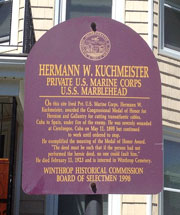 |
| Hermann W. Kurchmeister |
|
"On this site lived U.S. Marine Corps Hermann W. Kuchmeister, awarded the Congressional Medal of Honor for Heroism and Gallantry for cutting transatlantic cables, Cuba to Spain, under fire of the enemy. He was severely wounded at Cienfuegos, Cuba on May 11, 1895 but continued to work until ordered to stop.
He exemplified the meaning of the Medal of Honor Award. 'The deed must be such that if the person had not performed the heroic deed, no one could fault him.' He died February 11, 1923 and is interred in Winthrop Cemetery." |
| Metcalf Square |
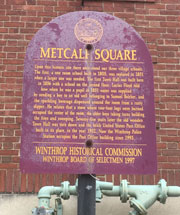 |
| Metcalf Square |
|
| "Upon this historic site there once stood our three village schools. The first, a room school built in 1805, was replaced in 1851 when a larger one was needed. The first Town Hall was built here in 1856 with a school on the second floor. Lucius Floyd told how when he was a pupil in 1851 water was supplied by sending a boy to an old well belonging to Samuel Belcher, and the sparkling beverage dispensed around the room from a rusty dipper. He relates that a stove where two-foot logs were burned occupied the center of the room, the older boys taking turns building the fires and sweeping. Seventy years later the old wooden Town Hall was torn down and the brick United States Post Office built in it place, in the year 1932. Now the Winthrop Police Station occupies the Post Office building since 1993."
|
| Point Shirley |
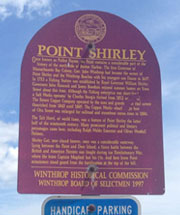 |
| Point Shirley |
|
"Once known as Pullen Poynte, the Point contains a considerable part of the history of the north side of Boston Harbor. The first Governor Massachusetts Bay Colony, Gov. John Winthrop had become the owner of Point Shirley and the Winthrop Beaches with his youngest son Deane in 1637. In 1753 a Fishing Station was established by Royal Governor William Shirley. Governors John Hancock and James Bowdoin enjoyed summer homes on Siren Street about this time. Although the Fishing enterprise was short-lived, a Salt Works operated by Charles Sturgis thrived from 1812 until 1841. The Revere Copper Company operated by the sons and grandsons of Paul Revere flourished from 1845 until 1869. The Copper Works wharf from the foot of Otis Street was enlarged for railroad and steamboat connections in 1884.
The Taft Hotel, or world fame, was a feature of Point Shirley the latter half of the nineteenth century. Many prominent political and literary personages came here, including Ralph Waldo Emerson and Oliver Wendell Holmes.
Shirley Gut, now closed forever, once was a considerable waterway. Lying between the Point and Deer Island, a fierce battle between British and American Patriots was fought during the Revolutionary War, where the brave Captain Mugford lost his life. And here brave Point minutemen stood guard from the fortification at the top of the hill."
|
| The Pit |
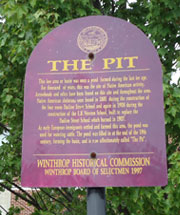 |
| The Pit |
|
"This low area or basin was once a pond formed during the last ice age. For thousands of years, this was the site of Native American activity. Arrowheads and relics have been found on this site and throughout the area. Native America skeletons were found in 1881 during the construction of the four room Pauline Street School and again in 1908 during the construction of the E.B. Newton School, built to replace the Pauline Street School which burned in 1907.
As early European immigrants settled and farmed this area, the pond was used for watering cattle. The pond was filled in at the end of the 19th century, forming the basin, and is now affectionately called 'The Pit'."
|
| W.J. Reid Boat Building Yard |
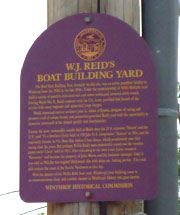 |
W.J. Reid Boat
Building Yard |
|
"The Reid Boat Building Yard, formally on this site, was an active maritime facility in Winthrop from the 1920s to the late 1950s. Under the proprietorship of Willis Reid, the yard built a variety of small-to-mid-sized sail and motor yachts, and powered utility vessels. During World War II, Reid’s contract with the U.S. Navy provided that branch of the service with many tugboats and motorized cargo barges.
World renowned marine architect John G. Alden of Boston, designer of racing and pleasure craft of unique beauty and proportion, provided Reid’s yard with the opportunity to showcase watercraft of the utmost quality and functionality.
Among the more memorable vessels built at Reid’s yard were the 29 ft. schooner “Aloette” and the 32 ft. yawl “Two Brothers” (both built in 1931), the sloop/cutter “Tamora” in 1934, and regionally famous 16.9 ft. Mass Bay Indian Class sloops, which prominently won their facing class for years. But perhaps Willis Reid’s most noteworthy vessel was the wooden motor yacht “Chiro” built in 1932. After relocating to the west coast it was renamed “Norwester” and became the property of John Wayne and his business manager. Until it was sold in 1963, the regaled Hollywood elite with deep sea fishing parties. The craft still cruises the coast of the Pacific Northwest to this day.
With the demise of the Willis Reid boat yard, Winthrop’s boat building came to an unceremonious close, and another chapter in Winthrop’s history was gone forever."
|
| |
|
|
|